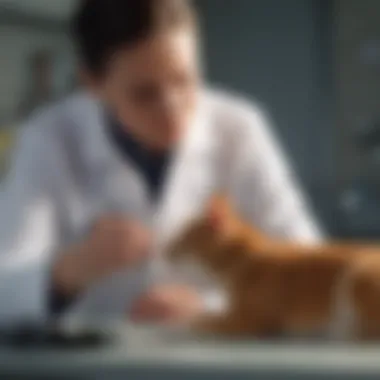Recognizing Blockage Symptoms in Pets for Better Health


Intro
Recognizing health issues in pets is vital for ensuring their well-being. Blockage symptoms can manifest in various forms, indicating an underlying medical problem. Understanding these symptoms allows pet owners not just to react adequately but also to prevent further health complications.
In this article, we will explore how to identify signs that may suggest a blockage in your pet and the importance of seeking timely medical attention. The knowledge gained will help empower pet owners to make informed decisions about their pets' health.
Understanding Your Pet
Recognizing blockage symptoms starts with understanding your pet’s unique characteristics. Different breeds may exhibit varying health issues, and their temperaments can influence how they show signs of distress.
Breed Traits
Each breed has specific health predispositions. For example, small breeds like Dachshunds are more prone to digestive issues compared to larger breeds. Learning about the traits of your pet's breed can provide insight into potential health risks.
Common Temperaments
Pets have individual temperaments that might affect their behavior when they are unwell. Some may become more withdrawn, while others may display aggressive behavior when in pain. Understanding these nuances is essential in recognizing when something is amiss.
Special Needs
Some pets may have unique care requirements due to their breeds or previous health conditions. Recognizing and accommodating these needs can improve their overall health and reduce the risk of blockages.
Pet Care Essentials
Engaging in proper pet care can significantly lower the chance of health issues, including blockages. Three main areas to focus on include nutrition, grooming, and overall wellness.
Nutrition and Feeding Guidelines
Proper nutrition is fundamental for your pet's digestive health. Feeding a balanced diet that is appropriate for their age, breed, and specific health needs is critical. Pay attention to the ingredients in their food to avoid common allergens that may lead to digestive issues.
Grooming Tips and Techniques
Regular grooming can prevent health problems. Pets that are not groomed properly may ingest fur while grooming themselves, leading to possible blockages. Comb your pet regularly to reduce shedding and minimize fur ingestion.
Health and Wellness
Routine veterinary check-ups help catch potential issues early. Vaccinations and regular health screenings can ensure your pet remains healthy and any risks of blockages are managed proactively.
Training and Behavior
Training plays a significant role in a pet's emotional and physical health. Proper training not only ensures a well-behaved pet but can also help improve their overall health through structured activity.
Basic Training Techniques
Establish basic commands that promote good behavior. Training sessions should be short and rewarding, fostering a positive relationship between you and your pet.
Behavioral Problems and Solutions
If a pet begins to show signs of anxiety or distress, it is essential to address these behaviors. Behavioral issues can sometimes contribute to health problems, including stress-related blockages.
Mental Stimulation Activities
Engage your pet in mental activities such as puzzle toys or training games. Keeping their minds active can help reduce anxiety and promote a more relaxed disposition.
Engaging with Your Pet
Interaction with your pet strengthens your bond and aids their health. Regular engagement through play and exercise is beneficial for both physical and mental wellbeing.
Interactive Games and Toys
Provide toys that encourage active play. Rotate toys regularly to keep your pet interested and mentally stimulated.
Safe Outdoor Activities
Take your pet on regular walks or to pet-friendly parks. Outdoor experiences can improve their mental health and offer essential physical exercise.
Family-Friendly Pet Interactions
Involve family members in caring for and interacting with your pet. This teamwork not only builds a strong community for your pet, but also creates a nurturing environment.
Pet Adoption and Integration


For those considering adding a new pet to the family, it crucial to understand the adoption process and how to integrate a pet into your home successfully.
Choosing the Right Pet for Your Lifestyle
Consider your lifestyle before selecting a pet. Assess your daily schedule, activity level, and household dynamics to find the right fit.
Preparing Your Home for a New Pet
Creating a safe and welcoming environment is essential. Remove hazards, stock up on necessary supplies, and designate a space for your new pet.
Tips for Smooth Prolusion
When introducing a new pet to existing family members (both human and animal), take it slow. Monitor interactions to ensure everyone is comfortable and safe.
Understanding your pet’s needs is an ongoing process that requires attention and care.
By recognizing blockage symptoms early, you can make a significant difference in your pet’s health outcomes.
Foreword to Blockage Symptoms
Definition of Blockage Symptoms
Blockage symptoms in pets refer to a range of indicators signaling a potential obstruction in the gastrointestinal tract. These signs might manifest through various physical and behavioral changes. Typical indicators include vomiting, signs of pain, constipation, and loss of appetite, among others. Each symptom serves as a warning sign that something is wrong.
Understanding these symptoms requires attentiveness to changes in a pet's routine. For instance, sudden changes in eating habits or unusual vocalizations may indicate discomfort. This systematic approach toward observing pet behavior is vital for offering timely support and medical care. What differentiates blockage symptoms from more typical health concerns is they can escalate quickly if left untreated.
The Importance of Early Detection
Early detection of blockage symptoms can be life-saving for pets. Many pet owners may overlook subtle indicators, not considering them to be significant. However, recognizing these symptoms promptly can lead to timely veterinary care, which is crucial to prevent complications.
- Immediate action: Addressing these symptoms early on helps avoid severe conditions such as ruptured intestines or severe infections.
- Management of pain: Pets suffering from obstructions can experience significant discomfort. Immediate care can alleviate pain and enhance quality of life.
- Better prognosis: The chances of a favorable outcome improve dramatically with prompt treatment.
Timely veterinary intervention can significantly alter the health trajectory of your pet, making early detection a priority for all pet owners.
By being vigilant and educated about these symptoms, pet owners are better positioned to advocate for their furry friends’ health needs. Awareness brings empowerment in a pet's care journey.
Common Blockage Symptoms
Recognizing common blockage symptoms in pets is essential for early intervention and effective treatment. These symptoms can indicate serious underlying health issues that may worsen if left unattended. Understanding these signs enables pet owners to make informed decisions regarding their pet's health and can significantly affect the chances of a successful recovery. Here, we will explore various common symptoms that may indicate a blockage, helping pet owners to identify them proactively.
Vomiting and Regurgitation
Vomiting and regurgitation are often the initial symptoms pet owners notice. Both can be alarming, but they have different causes. Vomiting tends to involve the active expulsion of stomach contents, while regurgitation is a passive process, often bringing up food or liquid shortly after eating.
In dogs and cats, vomiting can result from various reasons, including dietary indiscretion, infections, or blockages. If your pet vomits repeatedly, it could signal a serious issue, such as an obstruction in the gastrointestinal tract.
Understanding the difference between vomiting and regurgitation is important, as it influences diagnosis and treatment.
Diarrhea and Constipation
These two conditions can reveal significant underlying health problems. Diarrhea may occur when the intestines are inflamed or react to irritants, such as foreign objects or parasites. On the other hand, constipation may suggest that food is not moving through the gastrointestinal tract properly, indicating a blockage. Both conditions are uncomfortable and can lead to severe dehydration if not addressed swiftly.
Monitoring the consistency and frequency of stool can provide valuable information to veterinarians.
Abdominal Pain and Discomfort
Abdominal pain in pets can manifest in various ways, including decreased movement, hiding, or expressions of discomfort. Signs may include whining, pacing, or a hunched posture. Pain in the abdomen often points to something significant, such as a blockage affecting the gastrointestinal system, leading to serious health consequences.
Being observant and noting behavioral changes can assist in determining whether your pet requires immediate veterinary attention.
Loss of Appetite
A noticeable decline in food intake is often a red flag. Loss of appetite can occur for many reasons, but when linked to blockage, it signals that your pet's body is not functioning correctly. A pet that refuses food may be experiencing discomfort or nausea, both of which warrant a veterinary examination. Identifying subtle changes in eating habits can be helpful in early detection of issues.
Excessive Lethargy
A shift in energy levels is another symptom worth noting. Excessive lethargy can indicate that something is wrong. A previously active pet becoming unusually tired may be experiencing discomfort, pain, or systemic illness from a blockage. Tracking changes in activity levels will help you assess if a visit to the veterinarian is necessary.
In summary, recognizing common blockage symptoms in pets is vital in ensuring their health and well-being. By being vigilant and proactive, you can take necessary action and seek veterinary assistance when needed.
Less Common Blockage Symptoms


Recognizing less common blockage symptoms in pets is pivotal for pet owners. While many are familiar with signs like vomiting or lethargy, more subtle indicators can easily go overlooked. This section highlights the importance of remaining vigilant for unusual behaviors that may signal underlying health issues. The sooner a pet owner identifies these signs, the better the chances of effective treatment and recovery.
Pacing or Restlessness
Pacing or restlessness in pets can often be mistaken for normal behavior. However, when a pet shows increased agitation, circling, or an inability to settle down, it may hint at discomfort or pain caused by a blockage. This symptom can be distressing for both the pet and the owner.
Pets may pace around the house, avoid their usual resting spots, or demonstrate repetitive movements. These behaviors may suggest they are unable to find relief from discomfort. It is crucial for pet owners to take these signs seriously and seek veterinary advice, especially if the pacing persists.
Behavioral Changes
Behavioral changes in pets are another significant indication of possible blockage. A pet that typically is sociable may suddenly withdraw or hide. Changes in interaction, playfulness, or even aggression can signal a distressing state caused by pain or discomfort related to a blockage.
Monitoring these changes is essential. Each pet has its unique personality. If a pet seems out of character, it should prompt investigation. Early intervention can prevent more serious health complications. Documenting any noticeable changes can assist veterinarians in making accurate assessments.
Unusual Vocalization
Unusual vocalization can signify discomfort or pain from a blockage. Pets may whine, cry, or growl more than usual. It’s important for owners to pay attention to these sounds. Changes in tone or frequency can be indicators of distress.
In many cases, a pet may vocalize in response to continuous pain. Therefore, observing not just the sound but the context is crucial. If paired with other symptoms like pacing or behavioral changes, it intensifies the need for prompt veterinary evaluation.
Understanding these less common symptoms is critical. Early recognition can lead to timely treatment, potentially saving a pet's life.
Causes of Blockage Symptoms in Pets
Understanding the causes of blockage symptoms in pets is crucial for early detection and effective management. Recognizing these factors enables pet owners to address health issues proactively and mitigate risks that can lead to severe consequences if left untreated. Knowing what can cause blockages contributes significantly to maintaining the overall health and well-being of pets.
Gastrointestinal Obstruction
Gastrointestinal obstruction often emerges as a primary cause of blockage symptoms in pets. This condition occurs when there is a hindrance in the digestive tract. Several factors can contribute to this obstruction. Pets may eat inappropriate items, such as toys or clothing, which can create a physical blockage. A sudden change in diet can also cause digestive disturbances. Symptoms of gastrointestinal obstruction can include vomiting, abdominal pain, and lethargy. Timely identification of this condition is essential for appropriate medical intervention.
Foreign Body Ingestion
Foreign body ingestion is a significant concern for pet owners. Pets are naturally curious and may swallow non-food objects. Items like plastic, rubber, or metal can cause serious issues. If these objects become lodged in the digestive track, they can lead to pain and discomfort. Signs of foreign body ingestion include drooling, difficulty in eating, and signs of abdominal distress. If you suspect that your pet has swallowed a foreign object, consult a veterinarian immediately.
Tumors and Masses
Tumors and masses within the gastrointestinal tract can contribute to blockage symptoms. These growths may be benign or malignant, but either can obstruct normal digestive processes. Symptoms often include weight loss, changes in appetite, and persistent vomiting. Regular veterinary check-ups are vital for early detection of such conditions, especially in older pets. Awareness of this potential cause can prompt proactive monitoring of any health changes in your pet.
Intestinal Parasites
Intestinal parasites are another less obvious cause of blockage in pets. These organisms, such as roundworms or tapeworms, can interfere with the digestive system. Although they may not always cause physical blockages, they can lead to inflammation or secondary issues that mimic blockage symptoms. Symptoms may include diarrhea, weight loss, and bloating. Regular deworming and fecal examinations should be part of a pet’s health strategy to prevent these parasites from causing health complications.
Understanding these causes allows owners to monitor their pets effectively. Not all symptoms indicate a blockage, but being informed can lead to quicker, potentially life-saving action.
Diagnosis of Blockage Symptoms
Diagnosis of blockage symptoms in pets is a critical step. Recognizing the symptoms early significantly influences outcomes. It can prevent severe complications and can save a pet's life. A systematic approach to diagnosis enables veterinarians to find the root cause effectively. A detailed assessment may involve several components, including veterinary examinations, imaging studies, and sometimes endoscopy procedures. Each method has unique strengths and can offer essential information.
Veterinary Examinations
Veterinary examinations are often the first step in diagnosing blockage symptoms. During an examination, a veterinarian can evaluate the general health of the pet. They will look for physical signs indicating distress or discomfort. Often, the veterinarian will ask about the pet's history. This includes changes in eating habits or abnormal behaviors. Vital signs will typically be assessed. These will include heart rate, temperature, and respiratory rate.
Identifying pain during the examination can be crucial. Pain assessment often contributes to identifying the site of the blockage. For example, the veterinarian might palpate the abdomen to check for any abnormal masses. This hands-on approach helps generate initial insights before further diagnostic tools are utilized.
Imaging Studies
Imaging studies play an important role in diagnosing blockage symptoms. They provide visual information about the internal structures of pets. Two common types of imaging used are radiographs and ultrasound.
Radiographs
Radiographs, also known as X-rays, are a primary diagnostic tool. They help visualize bones and some soft tissues. One key characteristic of radiographs is their accessibility. Many veterinary clinics have this equipment available. A significant advantage is that they are quick to perform. This makes them a popular choice for many! However, they may not show all types of blockages, particularly those involving soft tissues.
An aspect to consider is that radiographs expose pets to minimal ionizing radiation. This risk is considered very low compared to the benefits gained. One disadvantage is that if the blockage is due to a foreign body made of soft tissue, it may not be clearly visible on X-rays.
Ultrasound
Ultrasound is another imaging modality that provides unique benefits. This method uses sound waves to create images of internal organs. One key advantage is its ability to show soft tissues in real-time. This makes it useful for discovering obstructions caused by soft tissue masses or fluid accumulation.
Another unique feature of ultrasound is that it is non-invasive. Pets do not experience radiation exposure like with radiographs. However, it requires a trained technician and can be more expensive than X-rays.
Endoscopy Procedures


Endoscopy procedures offer a direct visual examination of the gastrointestinal tract. This method is sometimes used when other diagnostics are inconclusive. During an endoscopy, a flexible tube with a camera is inserted into the pet’s body. This allows for real-time observation. It can also facilitate the removal of foreign objects.
However, anesthesia is usually required, which carries some risk. Thus, this method is typically used when other diagnostics point to specific issues. In summary, using multiple approaches often gives the clearest picture in diagnosing blockage symptoms in pets.
Management and Treatment Options
Management and treatment of blockage symptoms in pets are crucial for safeguarding their health. Recognizing these symptoms early can be the difference between a simple treatment and a more complex intervention. Various options exist, each tailored to the underlying cause of the blockage. The primary aim is to relieve discomfort and restore normal function. Understanding these options helps pet owners make informed decisions about their pets' care.
Surgical Intervention
In some cases, pets may need surgical intervention to address blockage symptoms effectively. Surgical options are typically considered when other treatments are not sufficient. This can include removing foreign objects, tumors, or malformed structures within the gastrointestinal tract. Surgery can be invasive and risky, yet it often presents the most definitive solution for severe obstructions. Post-operative care is essential for recovery. Pet owners should closely monitor their pets and follow veterinary advice strictly to ensure healing.
Medical Management
Medical management often involves non-surgical approaches, which can be effective depending on the blockage's cause.
Fluid Therapy
Fluid therapy plays a vital role in managing pets with blockage symptoms. It helps to restore hydration, which can be critical, especially if the pet has been vomiting or has diarrhea. The key characteristic of fluid therapy is its ability to maintain electrolyte balance and promote overall health. This treatment is popular because it is non-invasive and can be adjusted based on the pet’s specific needs. However, while fluid therapy is generally safe, it does require careful monitoring to prevent fluid overload.
Medications
Medications are another essential component of medical management. They can relieve pain, reduce inflammation, and support the recovery of the gastrointestinal tract. Key characteristics of medications include their targeted action and availability in various forms, such as oral tablets or injectables. This flexibility makes them a beneficial option for many pets. However, pet owners should be cautious about potential side effects and ensure that medications are prescribed and monitored by a veterinarian.
Nutritional Considerations Post-Treatment
Post-treatment nutrition is crucial for pets recovering from blockage symptoms. A carefully balanced diet helps restore health and supports recovery. After surgery or medical management, it may be necessary to introduce a bland diet initially. Gradually, pets can return to their regular diet once they show positive signs of improvement. It is also important to monitor any changes in appetite or digestion, as these can indicate underlying issues needing attention. Pet owners should always consult their veterinarian about the best dietary approach for their pets' specific conditions.
Preventive Measures for Blockage Symptoms
Preventive measures play a crucial role in reducing the risk of blockage symptoms in pets. By implementing strategies before symptoms arise, pet owners can safeguard their pets' health and improve their quality of life. The focus here includes regular veterinary check-ups, monitoring dietary habits, and managing the environment. Each element contributes to a comprehensive approach that benefits both pets and their owners.
Regular Veterinary Check-Ups
Regular veterinary check-ups are fundamental in preventing blockage symptoms. Routine visits allow for the early detection of potential health issues, which may lead to blockages. During these appointments, veterinarians can perform thorough evaluations, including physical examinations and necessary tests. This proactive approach helps identify any underlying health problems before they escalate into serious conditions.
It is also important to discuss any concerns with the veterinarian. Pet owners should inform the vet about changes in behavior, appetite, or digestion. Reporting these changes enables veterinarians to tailor recommendations specific to the pet’s needs, significantly reducing the likelihood of obstruction-related illness.
Monitoring Diet and Eating Habits
Diet plays a vital role in preventing blockage symptoms. A balanced diet ensures pets receive the proper nutrition and reduces the chance of gastrointestinal obstructions. Pet owners should choose high-quality pet foods appropriate for their pet's age and health status. Additionally, observing eating habits is essential.
Some tips for monitoring diet include:
- Control portions: Prevent overeating, which can lead to digestive issues.
- Avoid table scraps: Human food can cause reactions in pets, leading to blockages.
- Introduce new foods gradually: Sudden changes in diet can upset a pet’s stomach.
Regularly assessing these feeding practices helps in identifying and correcting issues before serious symptoms appear.
Environment Management
Managing a pet's environment is equally important in preventing blockage symptoms. Pets often ingest foreign objects or hazardous materials if their surroundings are not carefully controlled. Ensuring that dangerous items, like small toys or inappropriate household materials, are kept out of reach can drastically reduce the risk.
Pet owners should prioritize:
- Cleaning up: Remove any small or harmful objects littering the area where the pet has access.
- Supervision: Keep an eye on pets during playtime, especially with toys or items they can choke on.
- Safe spaces: Create designated areas where pets can play without the risk of ingestion of dangerous objects.
By adapting these preventive strategies, pet owners can significantly reduce the risk of blockage symptoms, ensuring their furry friends remain healthy and happy.
Implementing preventive measures not only protects pets but also enhances the bond between pets and owners, fostering a sense of responsibility and care.
Ending
Blockage symptoms in pets represent a significant aspect of their health. Understanding these indicators can truly make a difference in timely intervention and, consequently, pet wellbeing. By summarizing the essential points discussed earlier, we highlight the intricate relationship between recognizing symptoms and implementing proper care strategies.
Summarizing Key Points
First, we explored various blockage symptoms, from common signs like vomiting and lethargy to less common ones such as unusual vocalizations. Each symptom serves as a critical signal that something may be amiss in a pet's health.
Next, we examined the common causes of these symptoms, which include gastrointestinal obstructions and foreign body ingestion. Knowing these causes is pivotal, as this understanding equips pet owners to make informed decisions regarding their pets’ health.
The importance of early detection cannot be overstated. Identifying symptoms promptly can drastically alter treatment paths, enhancing recovery options and outcomes. Moreover, the management and treatment options revealed the importance of veterinary consultations, as proper diagnosis often dictates effective treatment. While surgical intervention may be necessary at times, many cases can be managed through medical means.
Furthermore, preventive measures were discussed, emphasizing the role of regular check-ups and dietary monitoring. These actions can minimize the risk of blockage occurrences, ensuring that pets maintain their health and vitality.
“Timely intervention is paramount; every pet owner must remain vigilant.”
Encouragement for Pet Owners
Pet ownership is a rewarding experience but also comes with responsibilities. Understanding blockage symptoms is a crucial piece of ensuring your pet's health. Take proactive steps to observe your pet's behavior closely and stay aware of any changes. If any symptoms arise that could indicate a blockage, do not hesitate to consult with a veterinarian promptly. Your pet relies on you to make these crucial observations and decisions for their health. Empower yourself with knowledge, as it enables you to be the best advocate for your pet during times of need. Every small observation can contribute to a larger picture of health. Stay informed and engaged with your pet's wellbeing; it truly makes a difference.



